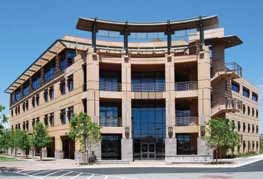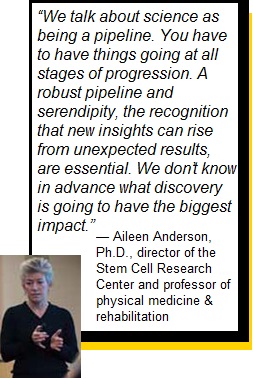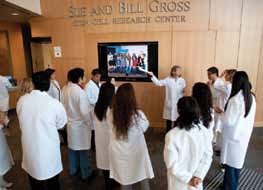Seed Grants
Investing in Seed Grants that Catalyze Discovery
Since 2006, the Sue & Bill Gross Stem Cell Research Center has played a leading role in the global effort to understand human development and transform medicine through basic, translational and clinical stem cell research.
- Basic research elucidates the mechanisms of how stem cells work in health and disease.
- Translational research discovers ways to take basic science and move it toward clinical use.
- Clinical research tests new stem cell therapies for safety and efficacy in humans with diseases or injuries.
Today, stem cells, and, more broadly, regenerative medicine, are our business. Interdisciplinary teams of 52 researchers from 23 academic departments and five schools, including medicine, biological sciences, engineering, arts and law, convene in our state-of-the-art research and clinical building to shape the future of biomedical research. Basic and translational scientists work side by side. The UCLA-UCI Alpha Stem Cell Clinic, housed in our building, serves as the coordinating hub for ongoing clinical trials, bringing us full circle from “bench to bedside” in stem cell research – all under one roof.
Our research teams increase our understanding of stem cells and explore novel therapies to improve health. Our treatments have reduced the effects of Alzheimer’s in animal models and enabled rats with spinal cord injuries to walk again. We are developing cell therapies to treat Huntington’s disease and preparing for clinical trials to use stem cells to treat stroke patients.
California has become one of the best places in the world to be a stem cell scientist, thanks in part to the California Institute for Regenerative Medicine (CIRM), a state agency created in 2004 to “accelerate stem cell treatments to patients with unmet medical needs.”* Stem cell scientists are flocking to California to explore uncharted territory, and UCI is poised to lead the way.
Fostering Innovation and Discovery
We have enormous opportunities to make life better for people, but without adequate funding for promising research, we risk leaving lives behind. Our Seed Grant Program addresses this issue by providing modest grants to researchers at the early stages of their work. This support enables scientists with big ideas to initiate bold research that paves the way for long-term successes.
Our Seed Grant Program funds innovative basic and translational research projects proposed by top stem cell investigators from across the UCI campus. These grants give recipients the freedom to explore new and currently unfunded avenues of stem cell research – and to take the types of calculated risks that may lead to medical breakthroughs.
With seed grants, visionary researchers test new ideas, advance understanding of human disease and explore novel therapeutic or diagnostic strategies to improve human health. After establishing proof of concept with their seed funds, investigators are well positioned to apply for larger extramural grants and long-term funding from CIRM, the National Institutes of Health (NIH) and other prestigious agencies.
The SCRC is proud to announce the funded projects for the 2020 SCRC Grant Awards. Congratulations!
- Munjal Acharya
- Bogi Andersen, James Jester, and Qing Nie
- Aileen Anderson
- Brian Cummings and Anita Lakatos
Ensuring a Competitive Edge
Recipients of our seed grants have a competitive edge when seeking the scarce research dollars available from external sources. In addition to presenting good ideas, our investigators are able to offer proof that their ideas can work. External funding enables them to move toward translational or clinical research projects with the potential to impact human lives.
Selecting Research Projects
We issue a request for proposals with just one restriction: Only unfunded research projects are eligible for a seed grant. Rather than supplement work others have funded, we’re committed to launching new projects. Impartial experts unaffiliated with the Stem Cell Research Center review the applications, looking for the best ideas. Like our colleagues at CIRM, our reviewers consider criteria such as whether the proposed projects will speed up the development of a stem cell treatment, increase the likelihood of success or fill an unmet medical need.
We receive more high-quality submissions than we’re able to fund – a testament to the exceptional work our stem cell researchers are doing.
All applicants receive constructive feedback from the reviewers about the feasibility of their proposals. Investigators who don’t receive seed grants from us often pursue funding for their projects from other sources, encouraged by the reviewers’ suggestions.
Exploring New Frontiers of Knowledge
Funding from our donors has made the Seed Grant Program possible. Since 2014, we have awarded $349,000 in seed grants to 13 researchers. These grants have ranged from $25,000 to $35,000. Research findings catalyzed by the grants have attracted $6.2 million in additional funding – a greater than 17-fold return on investment for studies of cancer, Alzheimer’s disease, traumatic brain injury, diabetes and other debilitating conditions.
Whether they focus on basic or translational research, recipients of our seed grants have the opportunity to explore new frontiers of knowledge in a supportive, collaborative environment that fosters innovation and discovery.

Catalyzing Discovery
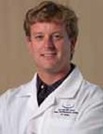
"I cannot overstate the impact my seed grant had on advancing my research. Because of this initial support, I've been able to establish methods to generate human microglia from stem cells. Microglia, an important immune cell that regulates the other cells of the brain, have been strongly implicated in the development of Alzheimer's disease."
— Mathew Blurton-Jones, Ph.D., associate professor neurobiology and behavior, Institute for Memory Impairments and Neurological Disorders and member of the Sue & Bill Gross Stem Cell Research Center
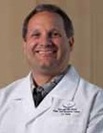
“Serendipity combines with creativity to open new insights. You can’t plan for serendipitous discovery. You just have to test new ideas and be open to the unexpected things that come out of them. That creativity is happening at the seed grant level.”
— Brian J. Cummings, Ph.D., professor & vice chair for research, physical medicine & rehabilitation and member of the Sue & Bill Gross Stem Cell Research Center
Cummings received a $33,000 seed grant in 2015 to develop 3D brain organoids that closely mimic human brain tissue. The organoids, miniaturized versions of the brain, are produced in vitro and can be used to study traumatic brain injury and brain diseases.
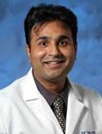
“The initial funding I received from a seed grant gave me hands-on experience with vital technical skills related to my neonatal chronic lung disease stem cell project. Additional funding would not have been possible without this support.“
— Muhammad Aslam, M.D., associate professor, Department of Pediatrics and member of the Sue & Bill Gross Stem Cell Research Center
Muhammad Aslam received a $30,000 seed grant in 2015 to develop a treatment using stem cells for chronic lung disease (CLD) in infants and children. This research could help establish therapies for infants and children suffering from CLD, a disease for which there are currently no effective treatments or preventive modalities.

“How does the human brain form? That was the question that motivated my seed grant proposal. The funding I received helped launch a new line of research in my lab that is now supported by the NIH Director’s New Innovator program. Through this work we are beginning to understand how mechanical forces shape the human brain.”
— Medha Pathak, Ph.D., assistant professor of physiology and biophysics and member of the Sue & Bill Gross Stem Cell Research Center
Medha Pathak received a $25,000 seed grant in 2017 to support her research on neural stem cells that build the brain. Her work has the potential to provide new insights into defective brain development and point us toward effective interventions, both in early life and during adulthood.
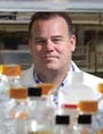
“The seed grant that I received from the SCRC allowed me to collect critical preliminary data, which was essential for my lab to be awarded additional, more extensive funding from a larger agency.”
— Jonathan Lakey, Ph.D., M.S.M., professor of surgery and biomedical engineering and member of the Sue & Bill Gross Stem Cell Research Center
Jonathan Lakey received a $35,000 seed grant in 2016 to support his type 1 diabetes research that uses a combination of stem cell science and bioengineering to design a pancreatic islet implantation device, which could eliminate the need to take lifelong anti-rejection drugs for patients with diabetes.
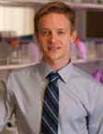
“Seed money was helpful because it helped us create a foundation for building the kinds of hypothesis-driven aims that funding agencies expect.”
— Maksim Plikus, Ph.D., associate professor of developmental & cell biology and member of the Sue & Bill Gross Stem Cell Research Center
Maksim Plikus received a $35,000 seed grant in 2017 to study the role of skin stem cells in wound healing and scar formation. His basic research is paving the way for new anti-scarring treatments after trauma or surgery.
| Awardee | Round | Amount | Follow-on Funds | New Awards and Publications |
|---|---|---|---|---|
| Boiko | 8/18/2014 | $25,000 | Update pending | |
| Cummings | 6/17/2015 | $33,000 | $1,700,000 |
CIRM DISC2 grant, June 2017 Published in Neuron, April 2017 |
| Inlay | 6/17/2015 | $33,000 |
$150,000 $150,000 |
Oxnard Foundation grant, January 2017 Alzheimer's Association of OC, March 2017 |
| Monuki | 6/17/2015 | $33,000 | $460,000 | NIH R21 grant, July 2016 |
| Blurton-Jones | 3/31/2016 | $35,000 | $2,700,000 |
NIH R01 grant, September 2017 Published in Stem Cells Translational Medicine, February 2017 |
| Lakey | 3/31/2016 | $35,000 |
$430,000 $290,000 |
JDRF grant, August 2016 City of Hope (NIH sub-contract), April 2017 |
| Plikus | 3/31/2016 | $35,000 | $240,000 |
PEW scholarship award, August 2016 Published in Science, January 2017 |
| Walsh | 1/26/2017 | $35,000 | Pending project update | |
| Donovan | 1/26/2017 | $35,000 | ||
| Pathak | 1/26/2017 | $25,000 | ||
| Downing | 1/26/2017 | $25,000 | ||
| Inlay | 3/22/2018 | $35,000 | ||
| O'Dowd | 3/22/2018 | $35,000 | ||
| Razorenov | 3/22/2018 | $35,000 |
| SUMMARY | ||||
|---|---|---|---|---|
| 14 awards | $454,000 | $6,120,000 | New funding enabled by seed grant program |
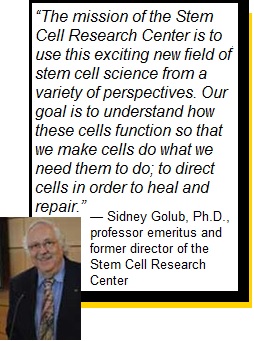
*“On November 2, 2004, 59% of the voters approved Proposition 71, which amended the California Constitution to establish the right to conduct stem cell research in California and authorize $3 billion to fund stem cell research.”https://www.cirm.ca.gov/about-cirm/history